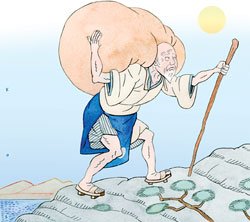Investors are understandably scared of the sovereign debt crisis unfolding in Europe. Amid their angst, however, they are ignoring a more likely, and significantly larger, debt catastrophe that is about to hit the nation with the second-largest economy in the world — Japan. Two decades of stimulative, low-interest-rate fiscal policy have made Japan the most indebted nation in the developed world, and as new Prime Minister Naoto Kan recently said, in his first address to Parliament, that situation is not sustainable. Japan has little choice but to raise interest rates substantially, with dire consequences far beyond its shores.
The prelude to the current crisis began in the early 1990s, after Japan’s housing and stock market bubbles burst and its economy slipped into recession. For the next 20 years, using flashy names like Fiscal Structural Reform Act, Emergency Employment Measures and Policy Measures of Economic Rebirth, the government cut taxes, increased spending and borrowed money to finance itself. Today, Japan’s ratio of debt to gross domestic product stands at almost 200 percent, more than twice that of the U.S. and Germany and second only to Zimbabwe.
A country with ballooning debt needs to have an expanding economy to outgrow the burden. Economic growth is driven by two factors: productivity and population growth. Although the Japanese economy may continue to reap the benefits of productivity gains, population growth is not in the cards.
Japan has one of the oldest populations in the developed world — every fourth person is 65 or older — and its number is on the decline. The Japanese birth rate is one of the lowest in the world, a meager 1.2 children per woman. To maintain its current population level, the average woman in Japan would need to give birth to 2.1 children. (Of course, only economists know how a woman can give birth to a fractional child.)
The severity of the debt problem in Japan has been masked by the fact that government spending on interest payments has not changed over the past two decades, as the average interest rate paid on the country’s debt declined to 1.4 percent in 2009 from more than 6 percent in the 1990s. This is about to change. Historically, more than 90 percent of Japan’s government-issued debt has been consumed internally by its citizens, directly or through its pension system. But the savings rate in Japan, which was in the midteens in the 1990s, today is approaching zero and will likely go negative in the not-so-distant future.
The Japanese economy operates on the assumption, soon to be proved false, that the government will always be able to borrow at low interest rates. As internal demand evaporates, the government will have to start hawking its debt outside Japan — in a more realistic world, where interest rates are a lot higher. Japanese ten-year Treasuries currently yielding 1.3 percent will not stand a chance against U.S. or German bonds of the same maturity, which yield 3.5 percent and 3 percent, respectively. Japan will have to offer rates far in excess of its U.S. and German counterparts. Although they have their own set of problems, the U.S. and Germany still have much lower indebtedness and superior demographic growth profiles.
Higher taxes and the austerity measures that undoubtedly will follow, combined with higher interest rates, will further slow Japan’s economy and drive the country toward insolvency. Unlike Greece, which because of its size could be bailed out by Germany and friends — with a little help from the ever-willing International Monetary Fund — Japan is too big to be bailed out. Defaulting on its debt, especially when the majority of it is held by its own citizens, is a political impossibility. But unlike European nations that socialized their currencies and cannot print euros on their own, Japan has complete control over its currency printing press. And print it will! Decades of deflation will turn into hyperinflation, which will destroy the purchasing power of Japanese citizens’ savings and collapse the yen.
The consequences of the economy’s slow but sure unraveling in Japan will spill over to the rest of the world. Japan is the second-largest holder of U.S. government debt, and most likely it will start selling Treasuries. To make matters worse, Japan will start competing with the U.S., not just in cars and electronics but for buyers of sovereign debt. As Japan exports inflation, interest rates around the globe undoubtedly will rise.
Timing bubbles — and Japan is in the late stages of an enormous debt bubble — is very difficult. They tend to last longer than rational observers expect. But as Japan’s debt continues to swell, the eventual bursting of the bubble grows more catastrophic.
Japan is proof that a country cannot borrow itself to prosperity. The U.S. and other developed nations still have a chance to make the politically difficult but right decision to cut fiscal spending and stop looking for government to be the source of sustainable growth — which it never is.










0 comments